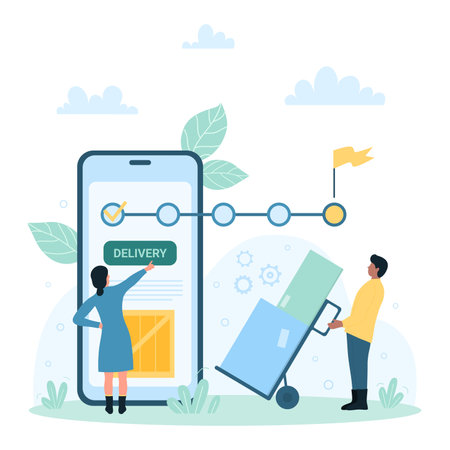1. The Rise of Mobile Job Hunting
In todays fast-paced world, smartphones have changed the way Americans look for jobs. Instead of sitting at a computer and searching through endless listings, people now use mobile job apps to find new opportunities anytime, anywhere. This shift has made job hunting more accessible and efficient, especially for those always on the move.
How Smartphones Changed Job Searching
Smartphones allow job seekers to search for positions while commuting, waiting in line, or even during lunch breaks. With just a few taps, you can browse openings, upload your resume, and apply within minutes. Mobile job apps send real-time notifications, so you never miss out on new postings or updates from employers.
Why Mobile Job Apps Are Popular in the U.S.
There are several reasons why Americans love using mobile job apps:
| Reason | Description |
|---|---|
| Convenience | You can search for jobs anytime, anywhere—no need to be tied to a desk. |
| Speed | Apply for jobs quickly with saved profiles and resumes. |
| Notifications | Get instant alerts about new job matches or application updates. |
| User-Friendly Design | Apps are designed for easy navigation on smaller screens. |
| Direct Communication | Message recruiters or employers directly within the app. |
Real-Life Example: A Day in the Life of a Mobile Job Seeker
Imagine Sarah, a recent college graduate in Los Angeles. She uses her phone to check job alerts during her morning coffee run. On her way to meet friends, she applies for two positions with just a few taps. Later that afternoon, she gets a message from a recruiter and schedules an interview—all without opening her laptop. This is the new normal for many Americans looking for their next career move.
2. Popular Mobile Job Apps in the U.S.
Looking for a new job in the U.S. is easier than ever, thanks to mobile job apps. Whether you’re searching for your first job or planning your next big career move, these apps make it possible to browse, apply, and connect with employers right from your smartphone. Here’s an overview of some of the most popular job search apps used by Americans and what makes each one unique:
Top Mobile Job Apps at a Glance
| App | Main Features | What Makes It Stand Out? |
|---|---|---|
| Indeed | – Massive job database – Simple search filters – Apply with your resume in seconds |
Known for having one of the largest listings and easy “one-click” applications. Great for quick searches across industries. |
| – Professional networking – Company profiles – Job alerts & referrals |
Merges social networking with job hunting. Perfect for building connections and getting referrals directly from your network. | |
| Glassdoor | – Company reviews & salaries – Interview insights – Real employee feedback |
Ideal for researching company culture and pay before applying. Helps you prepare for interviews with insider tips. |
| ZipRecruiter | – “One-tap apply” – Job matching notifications – Easy resume upload |
Uses smart-matching technology to recommend jobs that fit your profile. Employers can reach out to you directly. |
Choosing the Right App for You
The best app depends on what matters most to you. If you want lots of options fast, Indeed is a solid pick. If making professional connections is important, LinkedIn is the go-to choice. For those who care about workplace culture, Glassdoor’s reviews are invaluable. And if you like being matched quickly with new opportunities, ZipRecruiter’s notifications can give you an edge.

3. Best Practices for Applying via Mobile Apps
Crafting a Mobile-Friendly Resume
When you’re job hunting on your phone, it’s essential to make sure your resume looks great and reads well on any screen. Here are some practical tips to help you stand out:
- Keep It Simple: Use clean, easy-to-read fonts like Arial or Calibri. Avoid fancy formatting that may not display correctly on all devices.
- Use Bullet Points: Highlight key skills and achievements with bullet points for quick scanning.
- Short Sections: Break up text into short paragraphs and sections so recruiters can quickly find important information.
- Save as PDF: PDFs usually maintain their formatting across devices. Double-check how your resume appears on your own phone before submitting.
Quick Checklist: Mobile-Ready Resume
| Step | Description |
|---|---|
| Simple Layout | No graphics, columns, or unusual fonts |
| Easy to Scan | Brevity & bullet points for highlights |
| Contact Info First | Name, email, and phone at the top |
| Test on Your Phone | Preview before uploading or sending |
Managing Notifications Effectively
Mobile job apps often send real-time notifications about new postings, interview requests, or updates. Stay ahead by managing these alerts smartly:
- Customize Alerts: Set up notifications only for jobs or companies you’re truly interested in to avoid overwhelm.
- Snooze Non-Urgent Notices: Use the snooze feature if you’re busy but don’t want to miss opportunities later.
- Check Regularly: Make it a habit to check your app at set times each day so you don’t miss anything important.
Notification Management Tips Table
| Setting | Benefit |
|---|---|
| Job Matches Only | Saves time by filtering relevant opportunities |
| Email + Push Alerts | Covers both immediate and end-of-day review styles |
| Snooze During Work Hours | Keeps distractions low while working or interviewing elsewhere |
| Weekly Digest Option | Easier to manage if daily alerts are too much |
Staying Organized Throughout Your Job Search
A mobile job search can get overwhelming fast if you don’t stay organized. Here’s how to keep things under control:
- Create Folders/Labels: Many apps let you save jobs or create folders—use these features to sort positions by industry, location, or deadline.
- Track Applications: Keep a simple spreadsheet or use built-in tracking tools in the app to note where and when you’ve applied.
- Add Calendar Reminders: Schedule follow-ups and interviews right from your mobile calendar so nothing slips through the cracks.
- Regular Review: Once a week, review saved jobs and remove ones you’re no longer interested in so your list stays fresh.
Your Mobile Job Search Organization Plan
| Action Item | Description/Tool Suggestion |
|---|---|
| Create Folders/Labels | “Saved Jobs,” “Applied,” “Interview Scheduled” |
| Track Applications | Google Sheets or in-app trackers (like LinkedIn Job Tracker) |
| Add Calendar Reminders | Email/calendar app (Google Calendar, Outlook) |
| Purge Old Listings | Edit saved lists weekly for clarity and motivation boost |
The right strategies will help you make the most of mobile job apps and give you an edge as you look for your next opportunity—anytime, anywhere!
4. Navigating In-App Features for U.S. Employers
Understanding Key Features in U.S. Mobile Job Apps
When searching for jobs in the United States, mobile job apps like Indeed, LinkedIn, and ZipRecruiter offer user-friendly features designed to connect you with employers efficiently. Knowing how to use these features can help you stand out and speed up your job search process.
Essential In-App Features Explained
| Feature | What It Does | Why It Matters in the U.S. |
|---|---|---|
| Job Filtering | Lets you sort jobs by location, salary, company, remote options, and more. | Saves time by showing only relevant jobs based on your preferences and needs. |
| Instant Apply (Easy Apply/1-Click Apply) | Allows you to apply for jobs quickly with pre-filled information or a single tap. | Makes it easier to submit multiple applications in less time—a big plus in competitive markets. |
| Direct Messaging | Enables you to chat directly with recruiters or hiring managers within the app. | Helps build personal connections and get quick responses about your application status. |
How to Use These Features Effectively
- Customize Your Filters: Set filters for full-time or part-time roles, preferred locations (city or remote), and specific industries. Many U.S. employers post detailed requirements, so use keywords that match your skills.
- Take Advantage of Instant Apply: Before using “Easy Apply,” make sure your resume is updated and formatted according to U.S. standards—clear, concise, and free of personal photos or unnecessary information.
- Engage via Direct Messaging: If a recruiter reaches out through the app’s messaging system, respond promptly and professionally. This feature is widely used in the U.S., especially for tech, customer service, and administrative positions.
Quick Tips for Standing Out
- Add a short cover letter or introduction when possible—even if it’s optional. Personalizing your application can make a big difference.
- Enable notifications: Stay informed about new job postings or messages from employers so you never miss an opportunity.
- Keep your profile complete: Fill out all sections, including skills and certifications relevant to U.S. job markets.
By understanding and using these in-app tools wisely, you can increase your chances of landing interviews and finding the right job faster in the United States.
5. Staying Safe and Protecting Your Info
Why Security Matters When Using Job Apps
Mobile job apps make it easy to find your next career move, but they also require you to share personal information like your resume, email address, phone number, and sometimes even sensitive documents. In the U.S., job seekers need to be extra careful to protect their data from scammers and identity thieves.
Spotting Common Job App Scams
Not every job offer is real, and some apps or postings may try to trick you. Here are some red flags to watch out for:
| Red Flag | What It Means |
|---|---|
| Requests for payment upfront | Legit employers don’t ask for money to apply or get hired. |
| No company info or official website | If you can’t verify the employer online, it’s a warning sign. |
| Too-good-to-be-true offers | If the pay seems way above market average or you’re offered a job right away, be cautious. |
| Personal info requested too soon | You shouldn’t give out your Social Security Number, bank details, or full address until after a formal job offer and background check with a reputable employer. |
| Poor grammar and unprofessional communication | Scammers often send messages that sound odd or have lots of typos. |
Understanding Privacy Settings in U.S. Job Apps
Every app has its own privacy settings. Here’s how you can use them to keep your info safe:
- Limit Profile Visibility: Most apps let you control who sees your profile. Set it so only employers can view your information—not the general public.
- Select What You Share: Only upload documents or information required for the application. Don’t overshare on your profile.
- Email Alerts: Use app notification settings so only trusted companies can contact you directly.
- Password Protection: Create strong, unique passwords for each job app account and enable two-factor authentication when possible.
- Review App Permissions: Check what access the app requests on your phone (contacts, location, etc.), and disable any permissions that seem unnecessary.
Your Quick Safety Checklist
- Use official app stores (Apple App Store or Google Play) to download job apps.
- Read user reviews before signing up for any new platform.
- Avoid clicking links in suspicious emails or texts claiming to be from employers.
- If in doubt about a company or offer, research on sites like Glassdoor or the Better Business Bureau (BBB).
- Report suspicious activity within the app or to authorities like the Federal Trade Commission (FTC).
Remember:
Your personal info is valuable—treat it with care while searching for jobs on the go!


